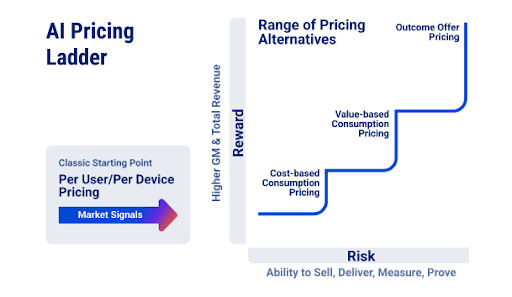The race for AI dominance isn't about technology. It's about who understands the new rules of value creation and who's still playing yesterday's game.
Everyone's mesmerized by the AI hype machine. Billion-dollar valuations. Jaw-dropping demos. Startups are burning cash like rocket fuel. Meanwhile, the real story—the one that will determine which companies dominate the next decade, and which become cautionary tales—is being written in the margins of profit and loss (P&L) statements and buried in failed enterprise deployments.
Key Takeaways
- Per-user pricing is dead and taking your revenue model with it. AI automates the tasks that humans are paid to perform. Climb TSIA's AI Pricing Ladder to value-based and outcome-based consumption models, or watch your margins evaporate as you deliver more value for less money.
- Services aren't optional in the AI era—they're your only defensible advantage. As AI capabilities become commoditized, differentiation arises from bridging the "last mile": AI readiness & governance, model optimization, and outcome-oriented services that contractually own business results.
- Incumbents have an unfair advantage, but it's one they can lose. You already possess the domain expertise and scalable services, which AI natives can't replicate. The question is whether you'll retool those assets for the AI economy, or cling to legacy models until you become irrelevant.
Three Hard Truths About the AI Economy
Here's what nobody wants to say out loud: Three Hard Truths About the AI Economy
- Truth #1: Your pricing model is killing you. Per-seat, per-user pricing worked when humans did the work. AI automates those humans away. You're making your product more valuable while vaporizing your own revenue stream.
- Truth #2: AI natives are burning billions with zero path to profitability. OpenAI loses $5 billion to make $3.7 billion in revenue. Cool tech. Mountains of venture capital. No viable economics. The emperor has no clothes, but everyone's too polite to notice.
- Truth #3: Incumbents have an unfair advantage—if they stop trying to be startups. You have domain expertise. Massive services scale. Existing customer relationships. The game isn't about who has the best AI, it's about who can actually deliver outcomes at scale.
Related: Pricing-Led Transformation Under AI Economics™
The AI Value Paradox: More Value Delivered, Less Revenue Captured
For sixty years, the rules were simple. Vendors provided tools. Customers made decisions. Customers owned the outcomes. Clean. Profitable. Predictable.
AI obliterates this arrangement.
Now the product makes the decision. Takes the action. And suddenly, you—the vendor—own the outcome. That accountability shift doesn't just change your liability exposure; it also affects your overall risk management strategy. It rewrites the entire economic contract between you and your customers.
This is the value paradox destroying business models across the industry: AI can make products exponentially more valuable by automating work, while simultaneously vaporizing the revenue model that made those products profitable. More value delivered. Less revenue captured.
You can't engineer your way out of this. You can't price your way around it. You need to fundamentally evolve your business model.
Related: AI Pricing Models Supercharge the Drive to Value Realization
Why AI Is the Era of Services (Not the End of Them)
Here's the uncomfortable truth the industry refuses to acknowledge: AI will not eliminate services. It will make services your greatest, defensible moat.
Everyone's obsessed with the technology layer: the models, the APIs, the infrastructure. They're missing the real game. As AI capabilities commoditize—and they will, faster than anyone expects—differentiation won't come from having better algorithms. It will come from bridging the "last mile" of AI adoption, ensuring ongoing optimization, and finally delivering the intended business value promised by the product.
The hurdles of that last mile are brutal:
- Messy, siloed enterprise data that hinders AI models.
- Legacy systems that weren't designed for intelligent automation.
- Compliance, security, and ethical governance nightmares.
- Vertical industry requirements that generic models can't touch.
Getting AI actually to deliver measurable business outcomes in a real enterprise environment? That demands a powerful services layer. Not the old, "implementation and support" services model. Something fundamentally different.
AI models are never static. The applications, infrastructure, and data around them are in constant flux. That’s why AI can’t be treated as a “set it and forget it” technology—it demands continuous management, optimization, and adaptation. Even AWS recognizes this reality, which is why some of its most critical AI offerings are delivered only as managed services:
- Amazon SageMaker: A fully managed platform covering the entire machine learning lifecycle, from data preparation to training, deployment, and monitoring. It can also integrate with managed MLflow to streamline experiment tracking and model management.
- Amazon Bedrock: A managed service that provides access to high-performing foundation models (FMs) from Amazon and top AI companies, enabling developers to build and customize generative AI applications with private data.
- Amazon Comprehend: A natural language processing (NLP) service that delivers sentiment analysis, entity recognition, key phrase extraction, and topic modeling to help enterprises make sense of unstructured text data.
The Three AI Service Categories Defining Industry Winners
TSIA's research reveals three revolutionary service categories emerging as the battleground for AI profitability.
AI Readiness & Governance Services (ARGS)
This is the foundation. Before a single model goes into production, enterprises must understand the intended business use cases and desired outcomes achieved through AI, then define an AI strategy, assess their data infrastructure, and navigate the complex landscape of legal, compliance, and ethical risks. Do it right or watch your AI initiative become a compliance disaster waiting to happen. It’s the core reason an MIT study found that 95% of AI projects fail to achieve ROI. They were doomed from the start.
Model Optimization Services (MOS)
This is where the real work happens. Generic AI models are toys. Customized models trained on proprietary customer data are weapons. MOS refers to the process of cleaning and transforming customer data, fine-tuning models for specific business contexts, and continuously optimizing them for optimal performance. This is high-margin, defensible work that AI natives can't easily replicate at scale.
Outcome-Oriented AI Services (OOAS)
This is the pinnacle. Stop selling technology. Stop the implementation of sales hours. Start contractually committing to specific, measurable business outcomes. "We'll reduce your customer churn by 15%" or "We'll cut your supply chain costs by $2M annually." That's not just a service—that's a partnership where you share risk and reward.
Related: Three Value Drivers for Three New AI Service Categories
The AI Pricing Ladder: Your Roadmap Out of the Death Spiral
TSIA's AI Pricing Ladder reveals the harsh reality: if you're still relying on per-user pricing, you're already at a disadvantage. Here's the climb.
Bottom Rung: Per-User/Per-Seat Pricing
This is where you die slowly. Every efficiency AI creates eliminates a user and your revenue. You're incentivized to keep customers less efficient. That's not a sustainable position.
Middle Rung: Value-Based Consumption Pricing
Charge based on usage, transactions, or value metrics that scale with customer success. When your customer wins, you win. This aligns incentives and protects you from the automation paradox.
Top Rung: Outcome-Based Pricing
The holy grail. You get paid when customers achieve specific business outcomes. This requires deep domain expertise, robust service capabilities, and the courage to own risk. It also commands premium margins and creates a lock-in that technology alone cannot.

Most AI natives are stuck at the bottom. Most incumbents are clinging to per-user pricing because they're terrified of short-term revenue disruption. Both are playing a losing game. The winners will be those who climb the ladder fastest—and that requires reimagining services as the core business, not an afterthought.
Why Incumbents Hold the Advantage in the AI Services Era
Marc Andreessen loves to declare: "All incumbents are gonna get nuked." He's wrong. And deep down, he knows it. The advantage belongs to the incumbents. Not because of your legacy technology—that's actually a liability you need to address through acquisition or aggressive innovation. But because of two unfair advantages, AI natives will never have:
- Decades of domain expertise in specific industries and use cases.
- Massive services scale is already in place, with thousands of consultants, implementation specialists, and customer success teams.
AI natives are scrambling to hire industry experts and build services teams from scratch. You already have them. The question is whether you're repurposing that advantage, or trying to engineer it away in pursuit of "product-led growth" fantasies.

The Incumbent's Playbook
- Stop trying to out-simplify the startups. Complexity doesn't disappear—it shifts. Embrace it. Your ability to handle enterprise complexity at scale is a feature, not a bug.
- Retool your services organization for the AI era. Your services team can't just implement and support anymore. They need to become Trusted Domain Advisors, operators, and optimizers who own outcomes. This involves acquiring new skills, adopting innovative pricing models, investing in new capabilities, and entering into new risk-sharing agreements.
- Make the pricing transformation now. Waiting for per-user revenue to decline before shifting to outcome-based models is like waiting for the Titanic to finish sinking before getting in the lifeboat. TSIA's frameworks show you how to make the transition without cratering short-term revenue.
- Develop AI-Centric Service Offers (ARGS, MOS, OOAS). Building out AI Readiness & Governance Services (ARGS), Model Optimization Services (MOS), and Outcome-Oriented AI Services (OOAS) ensures you’re not just supporting AI adoption, but actively driving it. These new categories position your services team as the linchpin for customers who need strategy, customization, and outcome ownership in the AI era.
- Acquire and develop AI technology aggressively. You can't build cutting-edge AI capabilities fast enough. Buy them. Integrate them. Wrap them in your domain expertise and scale your services. That's how you win.
The AI Services Race Is Already Underway
By 2028—likely sooner—the majority of enterprise AI spending will shift to proven AI offers and applications from vendors with global scale. Not self-service toolboxes. Not bleeding-edge foundation models. Holistic solutions that actually work, delivered by companies that can own outcomes.
There's a massive pot of gold waiting at that finish line. It's exponentially larger than the combined revenue of every AI startup today. And there's a version of that prize in every market segment, every vertical—including yours.
The companies that capture it won't be those with the best AI technology. Everyone will have good AI. The winners will be those who master the art of delivering, pricing, and contractually owning the business outcomes that AI enables. That requires services. Not the old kind. The new kind. The kind that turns AI from a cool technology into a profit engine.
Your Next Move in the AI Services Era
This isn't a moment to adapt. It's not even a moment to evolve. It's a moment to reimagine what a technology company can be. The race is already underway. The incumbents have the inside track. But advantages mean nothing if you don't know how to use them—or if you're too paralyzed by legacy thinking to leap.
TSIA has been analyzing industry data and building the frameworks, playbooks, and economic models that make this transformation possible. We've guided thousands of technology companies through market disruptions. This one is different. This one is existential. You can lead the Services Era or become a footnote in someone else's case study. There's no middle ground.
FAQ
Won't AI eventually automate away the need for services, making this a temporary advantage?
No. This is the single biggest misconception in the industry. As AI capabilities become more powerful and complex, the "last mile" challenge intensifies and the AI Complexity Avalanche grows. Enterprises need more help, not less—help with preparing data, tuning models, ensuring compliance, and translating AI outputs into actionable business decisions. The nature of services changes, but the need escalates. The companies that master AI-era services will build deeper moats than any technology alone could create.
How do we transition from per-user pricing to outcome-based pricing without destroying our existing revenue base?
TSIA's AI Pricing Ladder provides the framework. You don't flip a switch overnight. Start by introducing value-based consumption tiers alongside existing pricing. Test outcome-based pilots with innovative customers. Build the services capabilities required to deliver and measure outcomes. Gradually shift new customers and renewals up the ladder while managing legacy contracts through their natural lifecycle. The key is to start the transition now, not wait until per-user revenue collapses.
What if AI natives acquire their own domain expertise and services scale before we modernize our AI capabilities?
This is the real risk—but it cuts both ways. AI natives face a brutal challenge: building enterprise services organizations is expensive, slow, and culturally foreign to product-led startups. Most will fail at it. Your bigger risk is internal paralysis—executives who see services as a cost center to minimize, rather than the strategic weapon that will define the AI era. The companies that make the mental shift fastest will dominate. Those that don't will be acquisition targets for someone who does.
Smart Tip: Embrace Data-Driven Decision Making
Making smart, informed decisions is more crucial than ever. Leveraging TSIA’s in-depth insights and data-driven frameworks can help you navigate industry shifts confidently. Remember, in a world driven by artificial intelligence and digital transformation, the key to sustained success lies in making strategic decisions informed by reliable data, ensuring your role as a leader in your industry.





.png)



.png)




